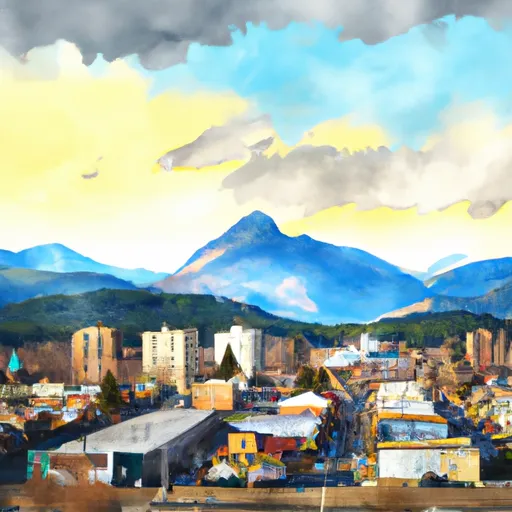-
 Snoflo Premium
Snoflo Premium
Get unlimited access to all our content
With no Ad interruptions! - Start Your Free Trial Login with existing account
Silver-Star
Eden Index
Climate
6.9
•
Recreation
2.0
•
Community
•
Safeguard
3.5/10

Silver-Star, Montana is a charming town nestled in the southwestern part of the state. Known for its picturesque landscapes and outdoor opportunities, Silver-Star attracts nature enthusiasts and adventurers throughout the year. The town experiences a typical Rocky Mountain climate, with relatively mild summers and cold winters. Average temperatures range from the mid-80s°F (30°C) in summer to the low-20s°F (-6°C) in winter, making it ideal for outdoor activities all year round.
Silver-Star is blessed with abundant hydrology constituents, including pristine rivers, crystal-clear lakes, and cascading waterfalls. The primary water source is the nearby Silver River, which provides opportunities for fishing, boating, and swimming. Additionally, the surrounding forests and mountainous terrain contribute to a variety of scenic hiking trails and camping spots, allowing visitors to immerse themselves in the natural beauty of the area.
Outdoor enthusiasts will find a plethora of recreational opportunities in Silver-Star. The town is a gateway to an extensive network of trails, offering hiking, mountain biking, and horseback riding opportunities. Wildlife viewing and birdwatching are also popular activities, as the region is home to diverse species. During winter, the area transforms into a winter wonderland, attracting skiers and snowboarders to its nearby slopes and cross-country skiing trails.
Overall, Silver-Star, Montana is a haven for those seeking an outdoor adventure, with its favorable climate, stunning hydrology constituents, and diverse range of activities available year-round.
What is the Eden Index?
The Snoflo Eden Index serves as a comprehensive rating system for regions, evaluating their desirability through a holistic assessment of climate health, outdoor recreation opportunities, and natural disaster risk, acknowledging the profound impact of these factors on livability and well-being.
Climate Health Indicator (CHI): 6.9
Silver-Star receives approximately
271mm of rain per year,
with humidity levels near 63%
and air temperatures averaging around
7°C.
Silver-Star has a plant hardyness factor of
5, meaning
plants and agriculture in this region thrive during a short period during spring and early summer. Most
plants will die off during the colder winter months.
By considering the ideal temperature range, reliable water supplies, clean air, and stable seasonal rain or snowpacks, the Climate Health Indicator (CHI) underscores the significance of a healthy climate as the foundation for quality living.
A healthy climate is paramount for ensuring a high quality of life and livability in a region, fostering both physical well-being and environmental harmony. This can be characterized by ideal temperatures, reliable access to water supplies, clean air, and consistent seasonal rain or snowpacks.
Weather Forecast
Streamflow Conditions
Missouri Headwaters
Area Rivers
Missouri Headwaters
Snowpack Depths
Missouri Headwaters
Reservoir Storage Capacity
Missouri Headwaters
Groundwater Levels
Recreational Opportunity Index (ROI): 2.0
The Recreational Opportunity Index (ROI) recognizes the value of outdoor recreational options, such as parks, hiking trails, camping sites, and fishing spots, while acknowledging that climate plays a pivotal role in ensuring the comfort and consistency of these experiences.
Access to outdoor recreational opportunities, encompassing activities such as parks, hiking, camping, and fishing, is crucial for overall well-being, and the climate plays a pivotal role in enabling and enhancing these experiences, ensuring that individuals can engage in nature-based activities comfortably and consistently.
Camping Areas
| Campground | Campsites | Reservations | Toilets | Showers | Elevation |
|---|---|---|---|---|---|
| Toll Mountain | 15 | 5,876 ft | |||
| Ladysmith | 6 | 5,789 ft | |||
| Boulder City Park | 5 | 4,898 ft | |||
| Delmoe Lake | 25 | 6,226 ft | |||
| Lowland | 11 | 6,610 ft | |||
| Pigeon Creek | 6 | 6,087 ft |
Catastrophe Safeguard Index (CSI):
The Catastrophe Safeguard Index (CSI) recognizes that natural disaster risk, encompassing floods, fires, hurricanes, and tornadoes, can drastically affect safety and the overall appeal of an area.
The level of natural disaster risk in a region significantly affects safety and the overall livability, with climate change amplifying these risks by potentially increasing the frequency and intensity of events like floods, fires, hurricanes, and tornadoes, thereby posing substantial challenges to community resilience and well-being.
Community Resilience Indicator (CRI):
The Community Resilience Indicator (CRI) recognizes that education, healthcare, and socioeconomics are crucial to the well-being of a region. The CRI acknowledges the profound impact of these elements on residents' overall quality of life. By evaluating educational resources, healthcare accessibility, and economic inclusivity, the index captures the essential aspects that contribute to a thriving community, fostering resident satisfaction, equity, and social cohesion.

